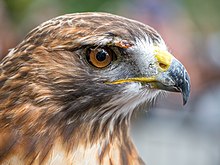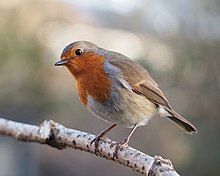Telluraves
Telluraves, also called land birds,[2] are a group of birds that live in trees.[3] Scientists recently grouped them using new genetic studies. This group includes many kinds of birds, such as songbirds, parrots, falcons, eagles, hawks, owls, and woodpeckers.[4] In 2022, George Sangster and others described this group using a rule called PhyloCode. They defined it by including two bird species: the sparrowhawk and the house sparrow.[5] Telluraves are closely related to another bird group called Phaethoquornithes.[6]
| Telluraves | |
|---|---|

| |
| Red-tailed hawk (Buteo jamaicensis) | |

| |
| European robin, Erithacus rubecula | |
| Scientific classification | |
| Domain: | Eukaryota |
| Kingdom: | Animalia |
| Phylum: | Chordata |
| Class: | Aves |
| Clade: | Neoaves |
| Clade: | Passerea |
| Clade: | Telluraves Yuri et al., 2013 |
| Clades | |
The oldest members of two bird groups in Telluraves—Afroaves (eagles, owls) and Australaves (seriemas, falcons)—are hunters. This led some scientists to think the first Telluraves were also hunters.[6] Others disagree, pointing to a plant-eating bird called Strigogyps.[7]
Not all studies agree that Afroaves is one single group.[8] In 2015, Prum and others showed a different family tree, placing hawks and vultures outside a group they called Eutelluraves.[9] Another study in 2019, led by Houde, grouped owls with hawks and vultures as a separate branch.[10] In 2024, Wu and colleagues supported this idea and named this branch Hieraves. They also said Australaves are closest to Hieraves, while a group called Coraciimorphae is the oldest branch of Telluraves.[11]
The cladogram of Telluraves here comes from a 2024 study by Josefin Stiller and others.[12] They used a bird species list updated in December 2023 by Frank Gill, Pamela Rasmussen, and David Donsker for the International Ornithological Committee. This list includes New World vultures as part of the hawk group.[13]
| Telluraves |
| ||||||||||||||||||||||||||||||||||||||||||||||||||||||||||||||||||||||||
References
changeCitations
change- ↑ Daniel T. Ksepka; Thomas A. Stidham; Thomas E. Williamson (2017). "Early Paleocene landbird supports rapid phylogenetic and morphological diversification of crown birds after the K–Pg mass extinction". Proceedings of the National Academy of Sciences of the United States of America. 114 (30): 8047–8052. Bibcode:2017PNAS..114.8047K. doi:10.1073/pnas.1700188114. PMC 5544281. PMID 28696285.
- ↑ Yuri, Tamaki; Kimball, Rebecca; Harshman, John; Bowie, Rauri; Braun, Michael; Chojnowski, Jena; Han, Kin-Lan; Hackett, Shannon; Huddleston, Christopher; Moore, William; Reddy, Sushma (2013-03-13). "Parsimony and Model-Based Analyses of Indels in Avian Nuclear Genes Reveal Congruent and Incongruent Phylogenetic Signals". Biology. 2 (1): 419–444. doi:10.3390/biology2010419. ISSN 2079-7737. PMC 4009869. PMID 24832669.
- ↑ Crouch, Nicholas M. A.; Ramanauskas, Karolis; Igić, Boris (2019-02-01). "Tip-dating and the origin of Telluraves". Molecular Phylogenetics and Evolution. 131: 55–63. Bibcode:2019MolPE.131...55C. doi:10.1016/j.ympev.2018.10.006. ISSN 1055-7903. PMID 30385308.
- ↑ Ericson, Per G. P. (2012). "Evolution of terrestrial birds in three continents: biogeography and parallel radiations". Journal of Biogeography. 39 (5): 813–824. Bibcode:2012JBiog..39..813E. doi:10.1111/j.1365-2699.2011.02650.x. ISSN 1365-2699.
- ↑ Sangster, George; Braun, Edward L.; Johansson, Ulf S.; Kimball, Rebecca T.; Mayr, Gerald; Suh, Alexander (2022-01-01). "Phylogenetic definitions for 25 higher-level clade names of birds". Avian Research. 13: 100027. Bibcode:2022AvRes..1300027S. doi:10.1016/j.avrs.2022.100027. ISSN 2053-7166.
- ↑ 6.0 6.1 Jarvis, Erich D.; Mirarab, Siavash; Aberer, Andre J.; Li, Bo; Houde, Peter; Li, Cai; Ho, Simon Y. W.; Faircloth, Brant C.; Nabholz, Benoit; Howard, Jason T.; Suh, Alexander (2014-12-12). "Whole-genome analyses resolve early branches in the tree of life of modern birds". Science (New York, N.Y.). 346 (6215): 1320–1331. Bibcode:2014Sci...346.1320J. doi:10.1126/science.1253451. ISSN 1095-9203. PMC 4405904. PMID 25504713.
- ↑ Mayr, Gerald; Richter, Gotthard (2011-09-01). "Exceptionally preserved plant parenchyma in the digestive tract indicates a herbivorous diet in the Middle Eocene bird Strigogyps sapea (Ameghinornithidae)". Paläontologische Zeitschrift. 85 (3): 303–307. Bibcode:2011PalZ...85..303M. doi:10.1007/s12542-010-0094-5. ISSN 1867-6812.
- ↑ Kuhl, Heiner; Frankl-Vilches, Carolina; Bakker, Antje; Mayr, Gerald; Nikolaus, Gerhard; Boerno, Stefan T; Klages, Sven; Timmermann, Bernd; Gahr, Manfred (2021-01-04). "An Unbiased Molecular Approach Using 3′-UTRs Resolves the Avian Family-Level Tree of Life". Molecular Biology and Evolution. 38 (1): 108–127. doi:10.1093/molbev/msaa191. ISSN 1537-1719.
- ↑ Prum, Richard O.; Berv, Jacob S.; Dornburg, Alex; Field, Daniel J.; Townsend, Jeffrey P.; Lemmon, Emily Moriarty; Lemmon, Alan R. (2015-10-07). "A comprehensive phylogeny of birds (Aves) using targeted next-generation DNA sequencing". Nature. 526 (7574): 569–573. Bibcode:2015Natur.526..569P. doi:10.1038/nature15697. ISSN 1476-4687.
- ↑ Houde, Peter; Braun, Edward L.; Narula, Nitish; Minjares, Uriel; Mirarab, Siavash (2019-07-06). "Phylogenetic Signal of Indels and the Neoavian Radiation". Diversity. 11 (7): 108. Bibcode:2019Diver..11..108H. doi:10.3390/d11070108. ISSN 1424-2818.
- ↑ Wu, Shaoyuan; Rheindt, Frank E; Zhang, Jin; Wang, Jiajia; Zhang, Lei; Quan, Cheng; Li, Zhiheng; Wang, Min; Wu, Feixiang; Qu, Yanhua; Edwards, Scott V (2024-02-12). "Genomes, fossils, and the concurrent rise of modern birds and flowering plants in the Late Cretaceous". Proceedings of the National Academy of Sciences of the United States of America. 121 (8): e2319696121. Bibcode:2024PNAS..12119696W. doi:10.1073/pnas.2319696121. PMC 10895254. PMID 38346181.
- ↑ Stiller, Josefin; Feng, Shaohong; Chowdhury, Al-Aabid; Rivas-González, Iker; Duchêne, David A.; Fang, Qi; Deng, Yuan; Kozlov, Alexey; Stamatakis, Alexandros; Claramunt, Santiago; Nguyen, Jacqueline M. T. (2024-05-01). "Complexity of avian evolution revealed by family-level genomes". Nature. 629 (8013): 851–860. Bibcode:2024Natur.629..851S. doi:10.1038/s41586-024-07323-1. ISSN 1476-4687. PMC 11111414. PMID 38560995.
- ↑ "IOC World Bird List – Version 14.2". www.worldbirdnames.org. Retrieved 2025-01-04.